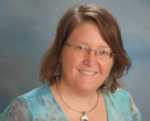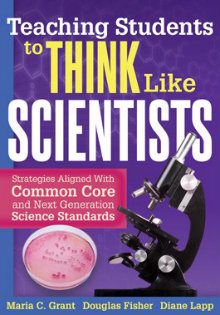Book about Scientific Thinking Best Suited for K-6 Teachers
Teaching Students to Think Like Scientists: Strategies Aligned with Common Core and Next Generation Science Standards
By Maria C Grant, Douglas Fisher, and Diane Lapp
(Solution Tree, 2014 – Learn more)

Teaching Students to Think Like Scientists was written to share ways to integrate literacy and science. It is best suited for elementary level classroom teachers, particularly language arts teachers. Each chapter begins with “What You’ll Learn in This Chapter” followed by Common Core standards and the evidence supporting those standards. The later part of each chapter provides grade-level specific (K – 6) ideas for integrating science in to the classroom.

Grant, Fisher and Lapp clearly value modeling as an instructional strategy. The book is filled with examples of modeling the scientific method, and writing and reading science for grades K – 6. The scenarios are detailed and provide great examples for teachers early in their careers or new to addressing science in the classroom.
Teaching Students to Think Like Scientists does a particularly good job of providing RAFT (Role, Audience, Format, and Topic) ideas for science writing. The authors break down RAFT ideas by grade level and also science field (physical, life and earth/space sciences). Their basic templates for explaining scientific discoveries (what I would term lab reports) are ideal for undeveloped writers.
Grant, Fisher and Lapp provide an extensive reference and resources section in the appendix. They also include many reproducibles (also available electronically), primarily graphic organizers.
Embedded within the chapters are “Questions for Discussion or Reflection.” I found the questions superficial and unengaging, for example, “Which grade-level NGSS and CCSS does your instruction address?” The reflection questions, like most of the book, I felt were geared more toward beginner teachers and teachers without expertise in science.
As an experienced, middle level science teacher I was bored reading this book. I was particularly frustrated by the amount of time Grant, Fisher and Lapp spent trying to convince the reader that incorporating science into the classroom is a good thing. In my opinion if someone doesn’t deem teaching science worthwhile they won’t bother reading this book. Having said that, Teaching Students to Think Like Scientists does have lots of ideas for integrating science in to language arts-based classrooms. Primary level educators looking for guidance on including more science in their classrooms may want to start here.
Tracey Muise, currently at St. George’s Episcopal School in Milner, GA, has been engaging and challenging middle school students for over fifteen years in a science classroom. Previously she taught at the Episcopal School of Knoxville (TN), Girls Preparatory School (Chattanooga, TN) and the Edmund Burke School (Washington, DC). She earned her M.S. in environmental education in 1996 from Antioch New England Graduate School and her undergraduate degree in biology, in 1990, from Drew University.


































